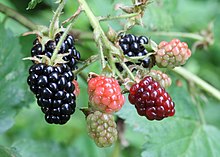
Back Blæcberige ANG عليق أسود Arabic Mur BAR Къпина (плод) Bulgarian ব্ল্যাকবেরি Bengali/Bangla Mouar Breton Kupina BS Mora (fruit) Catalan Mwyaren Welsh Brombær (frugt) Danish
| Blackberry | |
|---|---|

| |
| Ripe, ripening, and unripe Allegheny blackberries (Rubus allegheniensis) | |

| |
| Blackberry flower, Rubus fruticosus species aggregate | |
| Scientific classification | |
| Kingdom: | Plantae |
| Clade: | Tracheophytes |
| Clade: | Angiosperms |
| Clade: | Eudicots |
| Clade: | Rosids |
| Order: | Rosales |
| Family: | Rosaceae |
| Genus: | Rubus |
| Subgenus: | Rubus subg. Rubus |
| Species | |
And hundreds more microspecies | |
| Synonyms | |
|
Rubus subg. Eubatus | |
The blackberry is an edible fruit produced by many species in the genus Rubus in the family Rosaceae, hybrids among these species within the subgenus Rubus, and hybrids between the subgenera Rubus and Idaeobatus. The taxonomy of blackberries has historically been confused because of hybridization and apomixis, so that species have often been grouped together and called species aggregates.
Blackberry fruit production is abundant with annual volumes of 20,000 pounds (9,100 kg) per 1 acre (0.40 ha) possible, making this plant commercially attractive.[1]
Rubus armeniacus ("Himalayan" blackberry) is considered a noxious weed and invasive species in many regions of the Pacific Northwest of Canada and the United States, where it grows out of control in urban and suburban parks and woodlands.[2][3]
- ^ Carroll B (February 2017). "Commercial Blackberry Production". Division of Agricultural Sciences and Natural Resources, Oklahoma State University. Retrieved 10 April 2024.
- ^ "Himalayan blackberry". Invasive Species Council of BC. 2021. Retrieved 13 August 2021.
- ^ "Himalayan blackberry: identification and control". King County, Washington: Noxious Weed Control Program. 16 February 2021. Retrieved 13 August 2021.